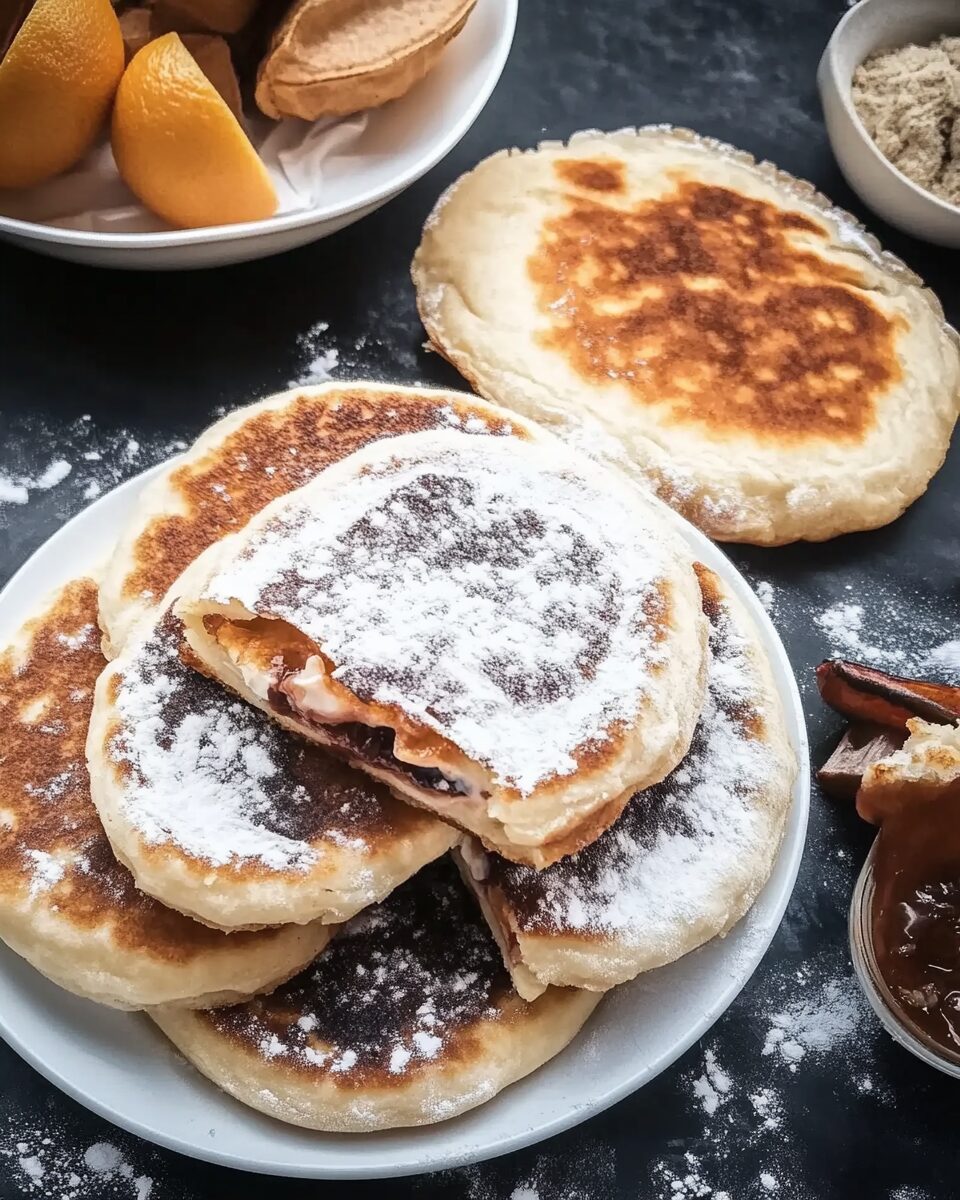Hotteok, or Korean Sweet Pancakes, are a popular street food in Korea, loved for their crispy golden crust and warm, gooey, sweet filling. These delicious pancakes are traditionally stuffed with a mixture of brown sugar, cinnamon, and nuts, creating a delightful combination of textures and flavors. Perfect for a snack or dessert, Hotteok is especially enjoyed during the colder months, offering a comforting and satisfying treat. Whether you’re looking for a new baking challenge or craving a sweet and chewy pancake, this recipe is a must-try!
Full Recipe:
Ingredients
- 2 cups all-purpose flour
- 1 cup warm milk
- 1 tablespoon sugar
- 1 teaspoon salt
- 1 teaspoon instant yeast
- 1 tablespoon vegetable oil
- 1/2 cup brown sugar
- 1 teaspoon ground cinnamon
- 1/4 cup chopped walnuts or peanuts (optional)
- Vegetable oil for frying
Directions
- In a large bowl, combine warm milk, sugar, salt, and instant yeast. Let it sit for 5 minutes until foamy.
- Gradually add the flour and vegetable oil, mixing until a dough forms. Knead for about 5 minutes until smooth. Cover and let the dough rise for about an hour, or until doubled in size.
- In a small bowl, mix brown sugar, cinnamon, and chopped nuts to create the filling.
- Punch down the dough and divide it into equal portions. Flatten each portion into a small circle, place a spoonful of filling in the center, and seal the dough around it, forming a ball.
- Heat a pan over medium heat with a little vegetable oil. Place a dough ball in the pan and press it down gently to flatten into a pancake.
- Cook for 2-3 minutes per side until golden brown and crispy.
- Serve hot and enjoy!
Nutrients
- Calories: 220
- Fat: 6g
- Carbs: 38g
- Fiber: 2g
- Sugar: 12g
- Protein: 4g
- Sodium: 180mg
The History of Hotteok
Hotteok has a rich history that dates back to the late 19th and early 20th centuries when Chinese merchants immigrated to Korea. These merchants introduced filled pancakes to Korean cuisine, and over time, Koreans adapted the recipe to create their own version, incorporating ingredients that suited local tastes. Unlike Chinese-style filled pancakes, which often contain savory fillings, Hotteok developed into a sweet treat, making it distinctively Korean.
During its early days, Hotteok was primarily a street food sold by vendors in bustling markets and neighborhoods. As Korea modernized, it remained a popular snack, particularly in colder seasons when warm, sweet foods are highly sought after. Today, Hotteok is not just a staple of Korean street food culture but has also found its way into bakeries, convenience stores, and even international cafes that specialize in Korean desserts.
The Signature Flavor and Texture of Hotteok
What makes Hotteok stand out among other pancakes is its unique combination of flavors and textures. The outer dough is slightly crispy when fried, while the inside remains soft and chewy. As you bite into it, the warm filling oozes out, releasing the sweet and nutty aroma of caramelized sugar and cinnamon. The contrast between the crunchy nuts and the gooey sugar filling makes every bite a delightful experience.
The traditional Hotteok recipe features brown sugar, cinnamon, and nuts, but modern variations have introduced creative fillings such as cheese, red bean paste, green tea-flavored custard, and even savory options like vegetables and meat. This versatility allows Hotteok to appeal to a wide range of palates, making it a fun dish to experiment with at home.
The Nutritional Benefits of Hotteok
Although Hotteok is considered a dessert or snack, it offers some nutritional benefits, particularly when made with whole ingredients. The dough, which consists of flour and yeast, provides carbohydrates for energy, while the nuts in the filling contribute healthy fats, protein, and essential vitamins. Nuts such as walnuts and peanuts are rich in antioxidants and omega-3 fatty acids, which support brain and heart health.
Brown sugar, a key component of the filling, contains molasses, which provides small amounts of minerals like calcium, potassium, and iron. While it is still a sugar-based treat, consuming Hotteok in moderation can be part of a balanced diet. Those looking for a healthier version can modify the recipe by using whole wheat flour, reducing the sugar content, or opting for fillings that include mashed fruits or natural sweeteners like honey.
How to Customize Hotteok
One of the great things about Hotteok is its versatility. While the classic version remains popular, many people enjoy experimenting with different ingredients to create new variations. Here are some popular ways to customize Hotteok:
- Nutty and Crunchy: Traditional Hotteok contains chopped nuts, but you can mix different types such as almonds, cashews, or sunflower seeds for added crunch and nutrition.
- Cheesy Delight: Adding shredded mozzarella or cream cheese to the filling creates a delicious balance of sweet and savory flavors. When heated, the cheese melts, giving the pancakes a gooey, stretchy texture.
- Chocolate Lovers’ Hotteok: Replace the traditional brown sugar filling with chocolate chips or Nutella for a rich and decadent twist. The melted chocolate blends beautifully with the warm dough.
- Red Bean Hotteok: A variation inspired by traditional Korean sweets, red bean paste can be used as a filling for a mildly sweet, earthy flavor. This version is perfect for those who enjoy less sugary desserts.
- Green Tea or Matcha Flavor: Adding matcha powder to the dough or filling enhances the flavor and gives the pancakes a vibrant green color. This variation pairs well with white chocolate or sweetened condensed milk.
- Savory Hotteok: Some versions of Hotteok swap out the sweet filling for a savory alternative, such as seasoned vegetables, kimchi, or shredded meat. These savory pancakes are great as a light meal or appetizer.
Pairing Hotteok with Other Foods and Drinks
Hotteok is delicious on its own, but pairing it with complementary foods and beverages can elevate the experience. In Korea, Hotteok is often enjoyed with a warm drink, especially during the winter months. Here are some great pairing ideas:
- Korean Barley Tea (Boricha): This mild, nutty tea is a popular choice to accompany Hotteok. The roasted flavor of barley tea balances out the sweetness of the pancakes.
- Milk or Soy Milk: A cold glass of milk helps mellow the rich caramelized filling, making it a favorite pairing for children and adults alike.
- Coffee or Espresso: The slight bitterness of coffee complements the sweet, spiced flavors of Hotteok, making it an excellent afternoon snack.
- Ice Cream: Serving Hotteok with a scoop of vanilla or cinnamon ice cream creates a delicious contrast between hot and cold elements.
- Fresh Fruits: Pairing Hotteok with sliced bananas, strawberries, or apples adds a refreshing touch that balances the richness of the filling.
The Cultural Significance of Hotteok
Hotteok is more than just a street food—it represents warmth, comfort, and nostalgia for many Koreans. The experience of watching street vendors skillfully press and fry the dough while the sweet scent fills the air is a cherished memory for many who grew up enjoying this treat. Families also enjoy making Hotteok at home as a fun and interactive cooking activity.
In Korean culture, food often brings people together, and Hotteok is no exception. It is commonly enjoyed with friends and family, whether at a bustling street market or in the comfort of home. During the winter months, the warmth of freshly made Hotteok serves as a comforting reminder of home and tradition.
Conclusion: Why You Should Try Making Hotteok
Hotteok is a must-try for anyone who loves sweets, enjoys exploring new cuisines, or wants to experience authentic Korean street food. With its crispy, chewy texture and rich, caramelized filling, it’s a dessert that delivers both comfort and indulgence in every bite.






